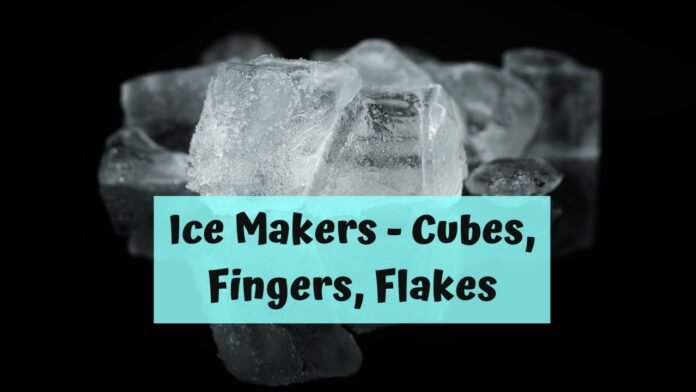In antiquity, another thousand years BC, this problem was solved with the help of glaciers. Chilled foods lasted much longer, and the ability to take chilled drinks to selected people in the heat brought additional positive emotions and a sense of superiority.
In the Middle Ages, due to the mixing of ice with salts, for example with saltpeter, it was possible to lower the temperature of the mixture below 0 ° C, which allowed cooling juices, wine and even making ice cream much faster.
The first ice maker, in the modern sense of the word, was made in America in the middle of the 19th century, and since then their distribution has expanded exponentially.
Artificially produced ice is used in medicine, construction, perfumery, and food industry but we will consider equipment for the production of ice and its use in catering and trade enterprises.
Before buying an ice machine, you need to determine what ice and for what purpose you will need.
In shape and appearance, ice can be shapeless and molded. The first type is granular and scaly, the second – cubic, although true hexagonal cubes are used very rarely, and by this name they mean hollow pieces of ice in the form of a truncated cone or cylinder (these ones also called “fingers”).
Granular ice is most similar to natural ice formed in snowdrifts in early spring. Its initial temperature is slightly below 0 ° C, it contains up to 25% water, so it has a moist amorphous structure. Granules the size of a pea do not freeze, adhere tightly to the refrigerated product, they do not have sharp edges, so they do not cut through the product or packaging.
Due to the large amount of water, they create a saturated moist environment around them, which is convenient for storing food drying in other conditions, such as fresh fish, leafy vegetables, berries. Granular ice is opaque, and colorful products look beautiful against its milky matte background. It can be successfully used for laying out perishable foods in salad bars, during the design of the buffet, for cooling caviar in caviar and champagne in buckets.
Flake ice is the coldest, its temperature does not exceed –6 … –8 ° С, and humidity does not exceed 2%. The scales resemble broken thin glass of irregular shape 1-2 mm thick. They do not freeze and, due to low temperature, have an increased cooling ability. Therefore, flake ice is used to cool large volumes of products and to transport goods that require cooling. For the accumulation of flake ice, special bunkers are used. They can be either a stand for an ice machine or stand-alone.
Cubic ice is the most common in the restaurant business. Shimmering with sparkling faces, it looks beautiful on the bar in a glass with alcoholic drinks and non-alcoholic cocktails, helps cooks to preserve asparagus chlorophyll color after cooking, and bakers thinly roll puff pastry.
The presence of a cavity inside the cones or fingers increases the area of contact and accelerates the cooling process (compared to real cubes).
The walls of the “fingers” are much thinner than the cones, so they can be crushed with a special blender faster and not so noisy.
Molded ice is produced in ice makers with a horizontally located evaporator with recesses into which thin trickles of water are pumped through nozzles. Frozen cones or cylinders thaw during the passage through the evaporator of warm freon vapor and fall into the storage hopper.
Ice makers can be air or water-cooled condenser unit. Most often used with air (primarily to save water, which after cooling goes into the sewer). Water cooling is used in a situation when in a cramped room with low ceilings the device needs to be squeezed between other equipment or furniture and it obviously will not have enough volume of cool air.
To connect the ice machine, you need to connect it to the power grid, cold water supply and provide for the drainage of excess water into the sewer.
Inventive Italian designers installed the ice maker directly in the refrigerated display case for laying out fish and seafood. The result was a successful symbiosis of refrigeration and demonstration equipment, which has become widespread inexpensive fish restaurants.
Of the innovations introduced in the production of ice makers, we note the application of bactericidal components (based on silver ions) on the plastic parts of the body and the device for the scoop holder inside the hopper, which reduces its microbiological contamination.
An additional unit has appeared in the ice makers of granular ice of high productivity, simplifying the packing of granules into bags and containers for further transportation.
As already mentioned, cube ice makers are the most common in bars and restaurants, but there is also a need for ice crumbs. Ice crushers help turn a piece of ice into small particles. For these purposes, use blenders (the instructions should say that it is suitable for these purposes) and disk ice crushers, with a rotating knife – as in a vegetable cutter, but with a massive clamping device. For safe operation, a microswitch is installed (“foolproof”), which turns on the device only after lowering the pressure device.
Useful Tips
Dirty, muddy ice in a glass with a noble drink will spoil the mood of the client for a long time. Therefore, it is strongly recommended to install a mechanical strainer, a water softener filter and regularly rinse the bath, from where the pump delivers water to the evaporator.
In size and weight, finger ice is divided into American – the largest, Spanish – medium-sized, and European – the smallest. Domestic bartenders prefer large ice, since together with a carbonated drink this creates the illusion of a full glass, regardless of the amount of alcohol poured.
The shape of the ice in the glass affects the taste. In disbelief, we offer in the well-known gin and tonic cocktail to replace ice cubes with its small crumbs (so that they pass through a straw) and add a pinch of powdered sugar. The difference will be overwhelming.











